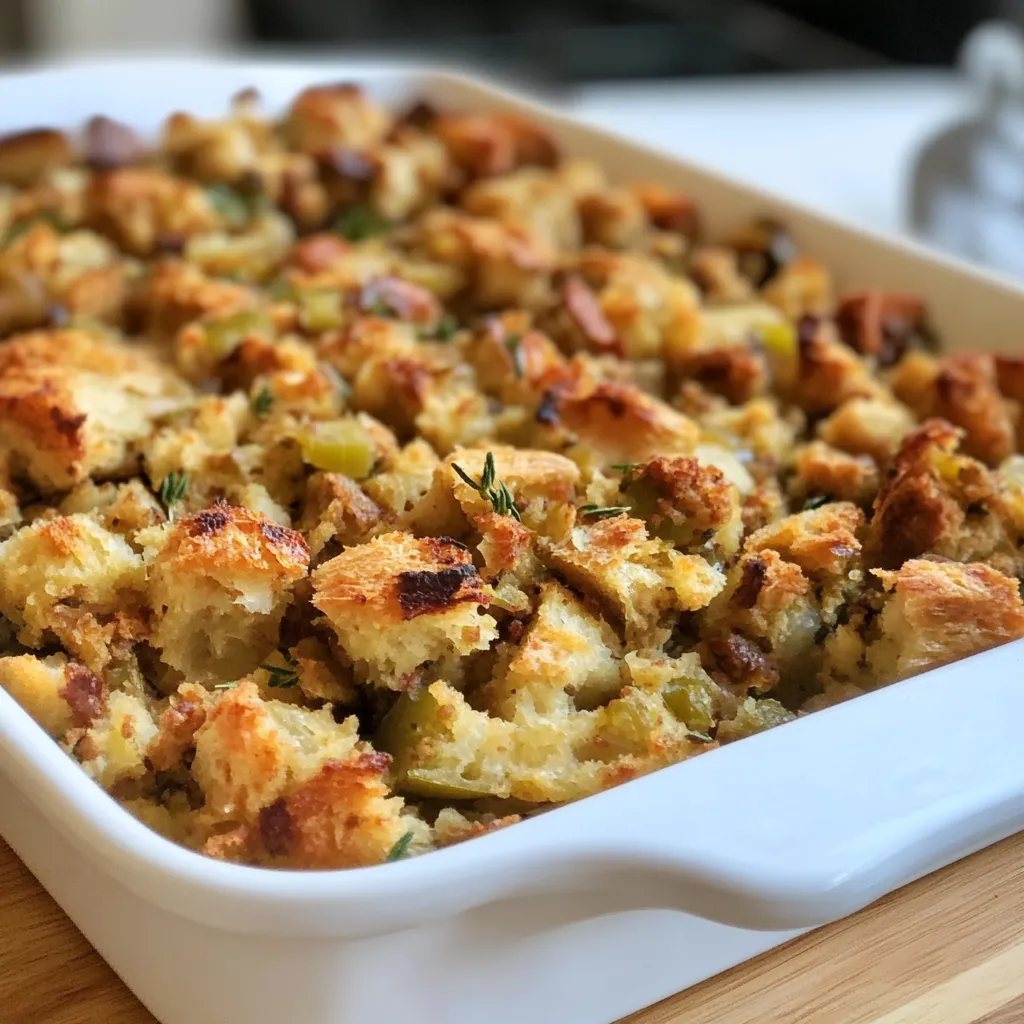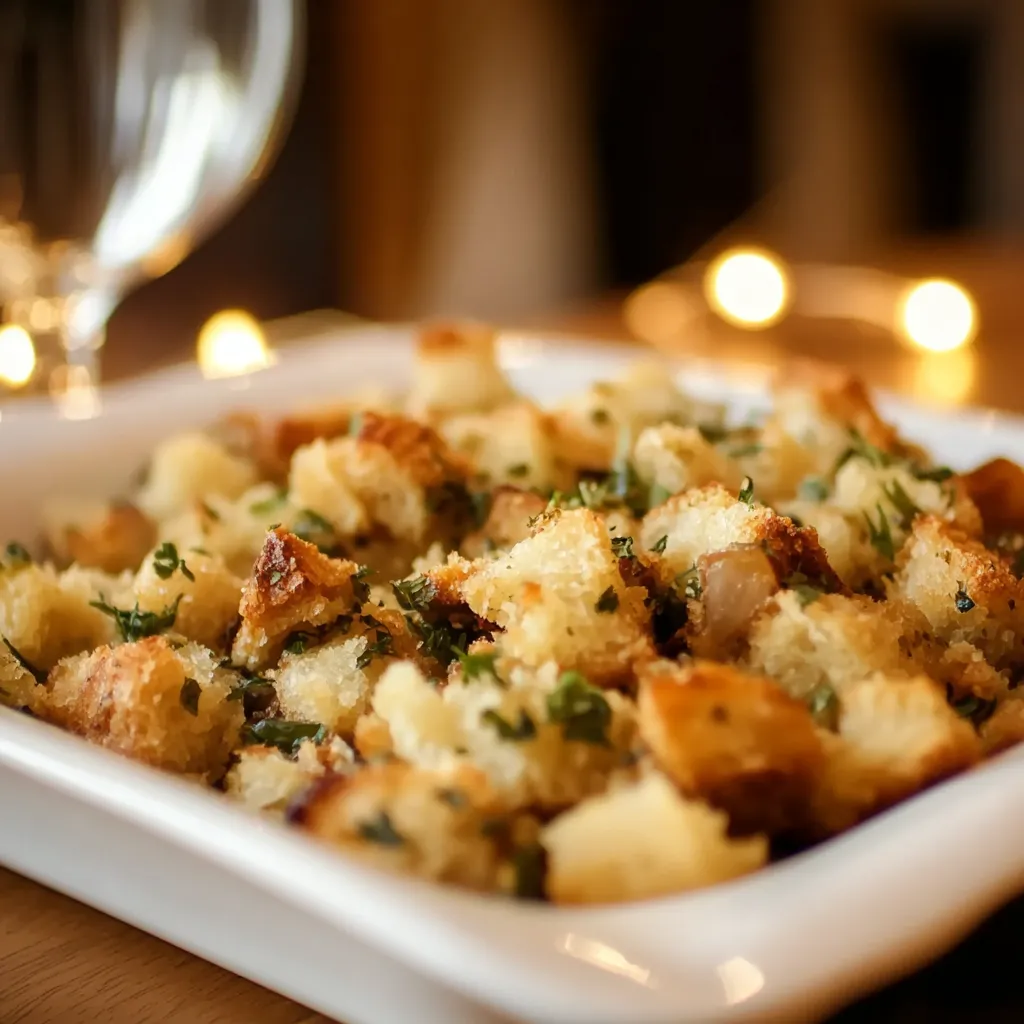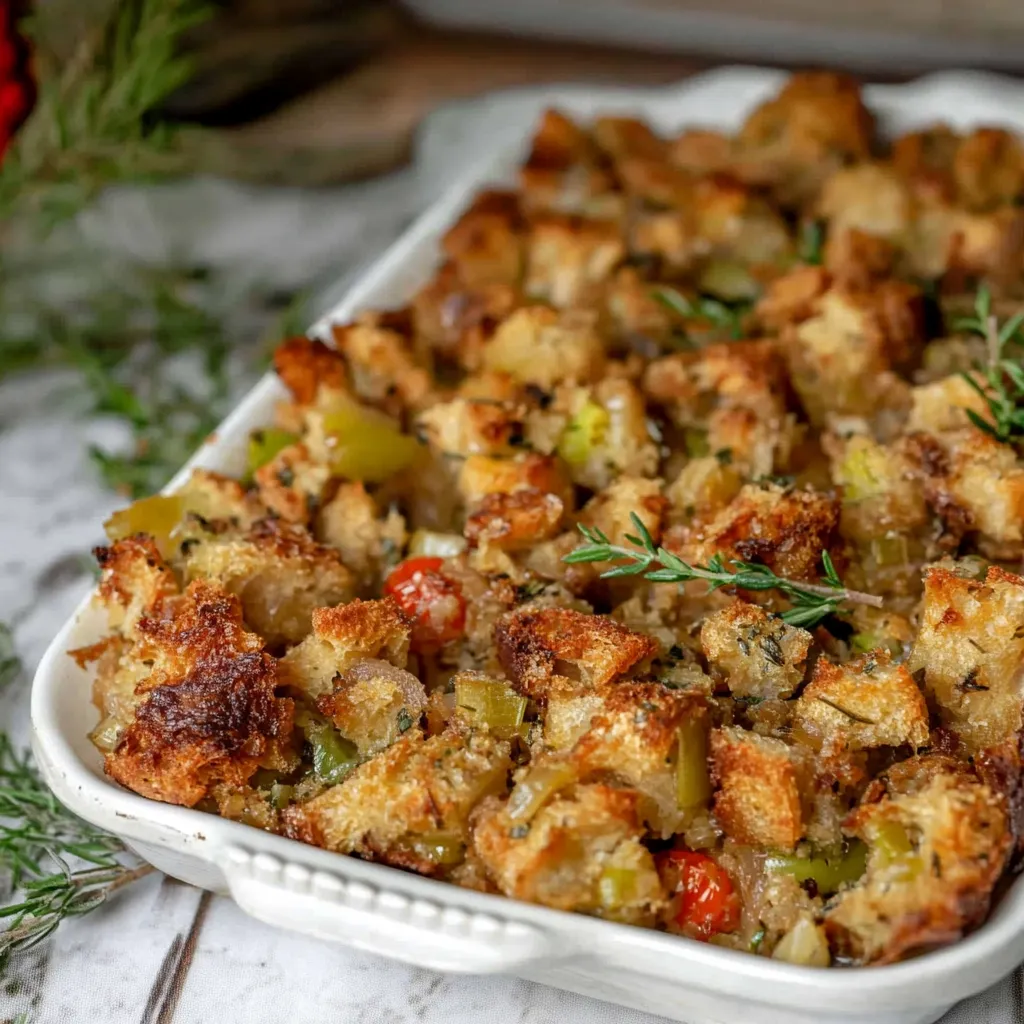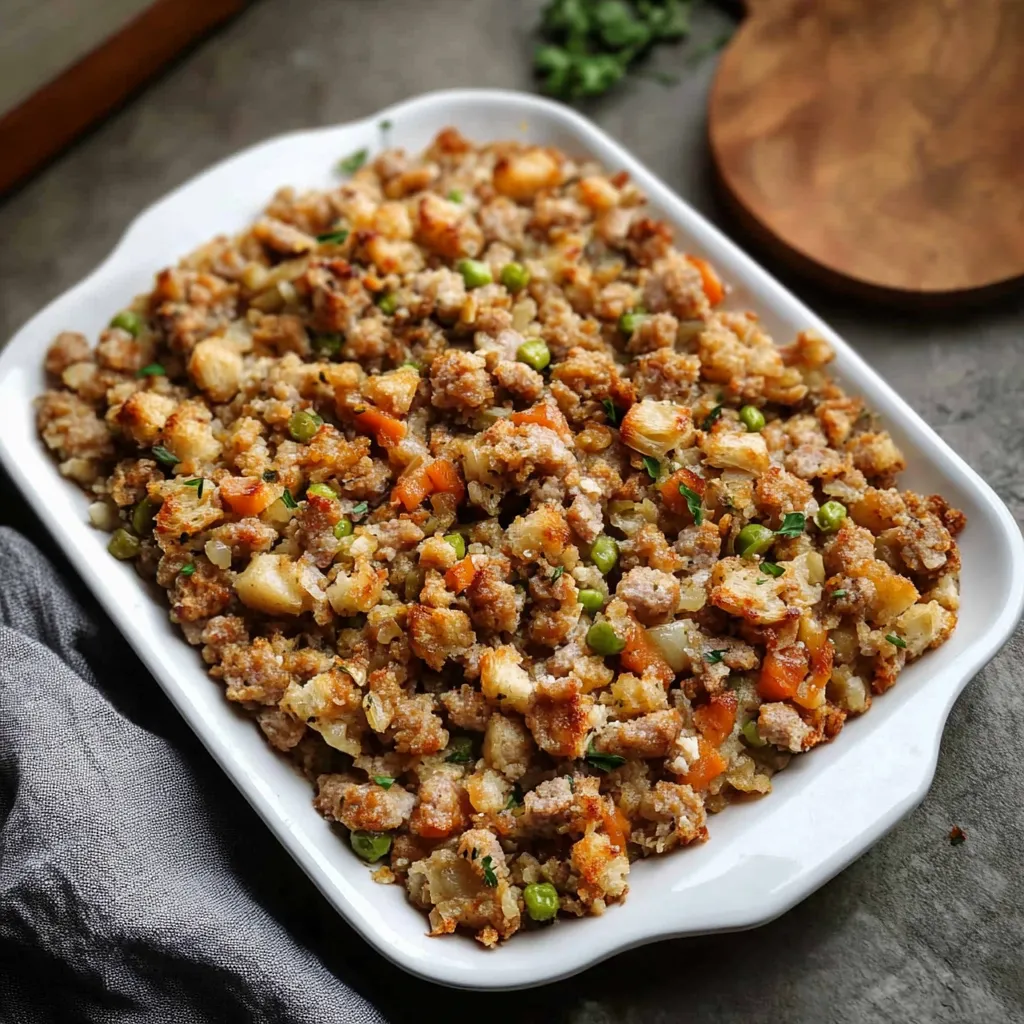When it comes to Thanksgiving, there’s one dish that no feast is complete without—stuffing! This Easy Stuffing Recipe is simple, flavorful, and perfect for pairing with turkey, chicken, or even pork. It’s a versatile side dish that combines soft, buttery bread cubes with a savory medley of vegetables and herbs, baked to golden perfection.
Whether you’re a seasoned cook or a beginner in the kitchen, this stuffing recipe is foolproof and guaranteed to be a crowd-pleaser at your next holiday gathering. It’s the perfect balance of textures—crisp on top, soft and moist in the middle, and full of flavor with the help of fresh ingredients and classic seasonings. In this article, I’ll guide you through how to make the perfect stuffing, including tips on the best bread to use, how to dry it properly, and ideas for making this dish ahead of time.

Ingredients for the Best Easy Stuffing
To make this stuffing recipe, you’ll need the following ingredients:
Bread: The foundation of any stuffing is the bread, and you have options! Use a combination of white and wheat bread for a slightly hearty stuffing, or go for sourdough or cornbread for more flavor. Make sure the bread is dried out so it absorbs the broth without becoming soggy.
Butter: Butter brings richness to the dish. It’s used to sauté the vegetables and adds moisture to the stuffing as it bakes.
Celery and Onion: These aromatic vegetables are key to providing flavor. They are sautéed in butter to create a savory base for the stuffing.
Herbs and Seasonings: Poultry seasoning, sage, thyme, and rosemary are the typical herbs used to flavor the stuffing. Feel free to adjust the seasoning to suit your taste.
Broth: Chicken broth is the classic choice, but vegetable broth works if you need a vegetarian option. The broth helps hydrate the bread, giving the stuffing its soft, moist texture.
Eggs: Eggs help bind the stuffing together, giving it structure and a slight richness.
With these simple ingredients, you can create a stuffing that’s both flavorful and comforting.

The Secret to Perfect Stuffing
While the ingredients are crucial, the real secret to making the best stuffing lies in the technique, especially how you prepare the bread and mix the ingredients.
1. Drying the Bread
Drying out the bread is essential. If your bread is too fresh, it will become soggy. The best way to dry it out is to cube the bread and leave it out for a couple of days before using it. This way, it will soak up the flavors of the broth without turning mushy. If you’re pressed for time, you can dry it in the oven. Simply spread the cubes on a baking sheet and bake at 300°F (150°C) for about 10-12 minutes, tossing halfway through.
2. Cooking the Vegetables
Sautéing the onions and celery in butter enhances their flavor and adds depth to the stuffing. Make sure to cook them over medium heat until they’re tender and fragrant. Don’t rush this step—it’s important for building flavor.
3. Moisture Control
Once the bread is dried and the veggies are cooked, it’s time to mix everything together. Pour the sautéed vegetables over the dried bread cubes, then slowly add the broth. Add the broth little by little until the bread cubes are moistened but not swimming in liquid. The goal is to make the stuffing moist but not soggy. If it’s too dry, you can always add more broth.
4. Seasoning and Flavor
Poultry seasoning is the go-to spice mix for stuffing, but feel free to adjust based on your taste preferences. Some people love extra sage or thyme, so be sure to taste and season as you go. Salt and pepper are essential, but don’t overdo them. The broth can add saltiness, so start with a small amount of salt and adjust later.
5. Baking
Once everything is combined, transfer the mixture into a greased baking dish. Bake the stuffing uncovered at 350°F (175°C) for about 35-45 minutes. The top should be golden brown and slightly crispy, while the middle remains moist and tender. Stir halfway through to ensure even baking.
How to Customize Your Stuffing
While this Easy Stuffing Recipe is delicious on its own, there are plenty of ways you can customize it to fit your taste or dietary needs. Here are a few variations and add-ins you can try:
Sausage Stuffing: Adding cooked sausage (pork or turkey) is a classic way to add richness and flavor. Simply brown the sausage before mixing it with the bread and vegetables.
Cranberries or Raisins: For a touch of sweetness, add dried cranberries or raisins. This pairs wonderfully with the savory herbs and vegetables.
Nuts: If you like some crunch, add chopped walnuts, pecans, or almonds. They bring an earthy flavor and texture contrast.
Apples: Chopped apples add a sweet, slightly tart flavor that complements the savory stuffing. Try using Granny Smith apples for a nice balance of sweetness and acidity.
Vegetarian Stuffing: To make this dish vegetarian, simply substitute the chicken broth with vegetable broth and skip the sausage. Add extra veggies, like carrots or mushrooms, for added flavor.
Tips for Making Stuffing Ahead of Time
If you’re looking to save time on Thanksgiving Day, this stuffing recipe can be made ahead of time. Here’s how:
Prepare the Stuffing: Follow the recipe through the mixing stage, but do not bake it yet.
Store in the Fridge: Cover the unbaked stuffing with plastic wrap or foil and refrigerate for up to 2 days before baking. If you make it a day ahead, it will have even more time for the flavors to meld.
Bake on the Day: When you’re ready to bake, remove the stuffing from the fridge at least 30 minutes before putting it in the oven. This helps it bake more evenly. You may need to add an extra 5-10 minutes to the baking time if it’s still cold from the fridge.
How to Freeze Stuffing
Leftover stuffing can be frozen for later use. Here’s how to store and reheat:
Cool Completely: Allow the stuffing to cool completely before freezing.
Package Properly: Transfer the stuffing to a freezer-safe container or wrap it tightly in plastic wrap and foil.
Freeze for up to 3 months: Label the container with the date to keep track of how long it’s been stored.
Reheat: When you’re ready to enjoy it, thaw the stuffing in the fridge overnight. Reheat in the oven at 350°F (175°C) for about 20-25 minutes, adding a bit of broth if it seems dry.
How to Choose the Best Bread for Stuffing
The bread you use plays a key role in the texture and flavor of your stuffing. Different types of bread will absorb the broth differently, and the right bread can take your stuffing from good to great. Here’s a guide to help you choose the best bread for your stuffing:
Types of Bread for Stuffing
White Bread: Classic and mild, white bread provides a soft texture that soaks up broth well. If you want a traditional stuffing flavor, white bread is always a good choice.
Wheat Bread: For a slightly heartier option, wheat bread can add a touch of nuttiness and extra texture. It’s great when combined with white bread for a balanced stuffing.
Sourdough Bread: If you’re looking to add a bit more flavor complexity, sourdough’s tangy notes can elevate your stuffing. It’s excellent in stuffing recipes that call for more savory additions like sausage or mushrooms.
Cornbread: For a Southern twist, cornbread is a fantastic option. It adds a crumbly texture and slightly sweet flavor. Mixing cornbread with white or wheat bread creates a unique stuffing with the perfect balance of texture.
Rye Bread: Rye bread can add an earthy depth to your stuffing, especially if you’re making a more rustic or savory version. It pairs well with roasted meats and hearty vegetables.
Tips for Selecting and Preparing Bread
Use Day-Old Bread: Fresh bread can become too soggy when mixed with broth. Use day-old bread that’s been sitting out for a day or two. It’ll have dried out slightly, which helps it soak up the broth without becoming mushy.
Dry the Bread: If you’re short on time, you can dry the bread in the oven. Cut it into cubes and bake it at 300°F (150°C) for about 10 minutes, ensuring it doesn’t brown or toast.
Cube the Bread Evenly: For consistent texture, make sure your bread cubes are roughly the same size. Aim for about ½ inch to ¾ inch cubes. Larger cubes can result in uneven cooking, while smaller cubes may absorb too much liquid.

How to Make Your Stuffing More Flavorful
While the basic ingredients of this Easy Stuffing Recipe are delicious, there are ways to elevate the flavor profile and make it even more exciting. Let’s dive into some tips and tricks for boosting the taste:
Add More Herbs
Herbs are the backbone of stuffing flavor. While poultry seasoning, sage, thyme, and rosemary are the go-to choices, feel free to experiment with other fresh herbs, such as:
Marjoram: Adds a sweet and slightly citrusy note, perfect for stuffing made with sausage or roasted meats.
Oregano: A great herb to use when making stuffing with Mediterranean flavors, like feta cheese and olives.
Bay Leaves: These can be added to the broth for a deep, slightly aromatic flavor. Just be sure to remove them before serving.
Enhance with Vegetables
Adding extra vegetables can make your stuffing more complex and colorful. In addition to the classic celery and onions, you can try adding:
Carrots: Grated or finely chopped carrots add sweetness and a nice crunch.
Mushrooms: Earthy mushrooms pair wonderfully with savory herbs and are a perfect addition for a rich, umami-packed stuffing.
Garlic: A few cloves of garlic sautéed with onions and celery will add aromatic depth to your stuffing.
Leeks: These give a subtle onion-like flavor and work beautifully in stuffing recipes where you want a lighter, slightly sweet vegetable taste.
Add Sweetness and Texture
If you like your stuffing with a bit of sweetness, try adding some of these:
Cranberries: Dried cranberries offer tartness and color, especially when paired with savory flavors.
Apples: Chopped apples, particularly tart varieties like Granny Smith, add a refreshing sweetness and slight crunch.
Nuts: Walnuts, pecans, or hazelnuts offer a delightful crunch and a nutty flavor that balances out the softness of the bread.
Sausage: Ground sausage, whether pork or turkey, is a hearty addition that adds richness and complexity to the stuffing. It pairs well with apples and herbs.
Use Broth and Stock Wisely
The type of broth or stock you use will impact the flavor of your stuffing significantly. Here are some options:
Chicken or Turkey Broth: For traditional stuffing, chicken or turkey broth is ideal. It enhances the stuffing’s flavor while keeping it moist.
Vegetable Broth: If you’re making a vegetarian stuffing, vegetable broth is a great substitute. It adds a subtle, earthy flavor to the stuffing.
Homemade Broth: If you have the time, homemade broth is the best option. It’s richer in flavor and can be customized with extra herbs, garlic, and vegetables to infuse more depth into your stuffing.
Stock vs. Broth: Stock is typically richer and has more body than broth due to the bones used in its preparation. If you want a fuller, more luxurious stuffing, go for stock. For a lighter version, broth is a good choice.

Serving and Storing Leftover Stuffing
How to Serve Stuffing
Stuffing is a perfect side dish for Thanksgiving, but it also pairs beautifully with other meals throughout the year. Here are a few ideas on how to serve it:
With Roasted Meats: Stuffing complements turkey, chicken, pork, and even beef. It soaks up juices from the meat, making each bite flavorful and satisfying.
As a Casserole: If you’re not stuffing a bird, stuffing makes an excellent casserole on its own. Add a sprinkle of cheese on top for extra flavor and texture.
As a Sandwich: Leftover stuffing makes for an amazing sandwich filling, especially with some leftover turkey and cranberry sauce.
Storing Leftover Stuffing
Leftovers are inevitable with stuffing, but don’t worry—it stores well!
Refrigerate: Store leftover stuffing in an airtight container in the fridge for up to 4 days.
Freeze: If you have more leftovers than you can handle, stuffing freezes well! Store it in a freezer-safe container for up to 3 months. When reheating, add a little broth to keep it moist.
How to Reheat Stuffing
Oven: Preheat the oven to 350°F (175°C). Spread the stuffing in a baking dish and cover it with foil. Heat for 15-20 minutes, adding a splash of broth to keep it from drying out.
Microwave: For quicker reheating, microwave the stuffing in a microwave-safe dish, adding a little broth. Heat in 30-second intervals, stirring each time, until hot.

Common Mistakes to Avoid in Stuffing
Making the perfect stuffing takes practice, but here are a few common mistakes you should avoid to ensure success every time:
1. Using Fresh Bread
As mentioned earlier, fresh bread is the biggest culprit when it comes to soggy stuffing. Always dry your bread cubes beforehand to ensure that the stuffing soaks up the liquid without becoming mushy.
2. Overcooking the Vegetables
While sautéing the onions and celery is important for flavor, make sure you don’t overcook them. Aim for tender but not caramelized vegetables. Overcooking them can lead to an overly soft stuffing with a less distinct vegetable flavor.
3. Adding Too Much Broth
It’s important to add the broth gradually and only enough to moisten the bread. If you add too much, the stuffing may become a soggy mess. Aim for moist, not swimming, stuffing. Add the broth in small amounts, waiting a minute for the bread to absorb it before adding more.
4. Not Letting Stuffing Rest
After baking, let the stuffing rest for about 10 minutes before serving. This allows the stuffing to set and helps retain its texture. Cutting into it immediately may cause it to fall apart.
Variations and Customizations
While this Easy Stuffing Recipe is delicious on its own, you can mix things up with different ingredients or flavors to fit your preferences. Below are some fun ideas to make this stuffing your own:
Add Sausage or Bacon
If you’re looking for a richer, heartier stuffing, add sausage or bacon. Brown the sausage or cook the bacon before mixing it into the bread and vegetable mixture. This addition will give your stuffing extra flavor and a satisfying bite.
Go Vegetarian
For a vegetarian version, skip the meat and use vegetable broth. You can also add mushrooms for an earthy flavor and carrots for a touch of sweetness.
Add Cheese
For a cheesy stuffing variation, consider adding grated Parmesan or cheddar to the mixture. The cheese will melt into the stuffing, adding a creamy, savory richness.
Sweeten It Up
For a sweeter twist, you can add dried cranberries, raisins, or chopped apples. These ingredients pair beautifully with the herbs and provide a delightful contrast to the savory flavor.
Make It Gluten-Free
If you need a gluten-free stuffing recipe, simply substitute gluten-free bread for regular bread. You can easily find gluten-free bread cubes in stores, or use your favorite gluten-free loaf and dry it out yourself. Pair with gluten-free broth for a completely gluten-free dish.
FAQs On Easy Stuffing Recipe
What is traditional stuffing made of?
Traditional stuffing typically includes bread cubes, onions, celery, butter, and a variety of herbs such as sage, thyme, and rosemary. It is often flavored with salt, pepper, and broth (chicken or turkey). Some variations may include additional ingredients like sausage, mushrooms, or dried fruit. The key is to create a savory, herb-infused mixture that soaks up the broth and is baked until golden.
How to make easy chicken stuffing?
To make easy chicken stuffing, start by sautéing onions, celery, and garlic in butter. Add poultry seasoning, thyme, sage, and salt for flavor. Combine the sautéed mixture with dry bread cubes in a large bowl. Gradually add chicken broth to moisten the bread, then bake until golden. You can also add cooked chicken or turkey for a more filling stuffing. This simple recipe can be made ahead of time and baked when ready.
What makes stuffing taste better?
To make stuffing taste better, focus on the seasoning. Use fresh herbs like sage, thyme, and rosemary for a more aromatic and flavorful stuffing. Adding sautéed vegetables like onions, celery, and garlic enhances the depth of flavor. For richness, include some sausage or bacon. You can also play with adding fruit like cranberries or apples, or a handful of nuts for crunch. Make sure to use a flavorful broth to help absorb all the herbs and spices.
Is it better to use stock or broth for stuffing?
Both stock and broth work well for stuffing, but stock is usually preferred for its richer, more concentrated flavor. Stock is made by simmering bones and vegetables for a long time, which gives it a fuller taste and more body. Broth, on the other hand, is made by simmering meat and vegetables and tends to be lighter in flavor. If you want a deeper, more flavorful stuffing, stock is the way to go, but broth will work fine if you prefer a lighter taste.
What is the best stuffing mix?
The best stuffing mix depends on personal preference, but Pepperidge Farm is a widely loved option for its variety of textures and flavors. You can also find stuffing mixes with added herbs or cornbread versions. If you prefer a more natural and homemade stuffing, you can use cubed day-old bread and add your own seasonings and broth to customize the flavor to your liking.
What happens if I use broth instead of stock?
Using broth instead of stock will result in a lighter flavor. Since broth is made from simmering meat and vegetables, it doesn’t have the rich, gelatinous quality that stock does (because stock includes bones). This might make the stuffing a bit less flavorful, but it’s still a good option if you prefer a lighter texture or are making a more delicate stuffing. You can always adjust the seasoning to balance the difference in flavor.

Easy Stuffing Recipe
Ingredients
2 small yellow onions, diced
4 ribs celery, diced
⅔ cup butter (unsalted)
1 ½ teaspoons poultry seasoning (or ½ teaspoon ground sage)
Black pepper, to taste
Salt, to taste
12 cups dry bread cubes (about 3 large loaves of bread)
2 to 4 cups chicken broth (or turkey broth, as needed)
2 tablespoons chopped fresh parsley (or 2 teaspoons dried parsley)
1 tablespoon fresh herbs (any combination of sage, thyme, or rosemary, or 1 teaspoon dried herbs)
Instructions
Preheat the oven to 350°F (175°C).
In a large skillet, melt the butter over medium heat. Add the diced onion, celery, and poultry seasoning (and rosemary if using). Reduce the temperature to medium-low and cook, stirring occasionally, until the vegetables are tender and translucent—about 10-12 minutes. Allow the mixture to cool slightly.
In a large bowl, combine the bread cubes, the onion-celery mixture, parsley, and fresh herbs.
Pour 1 cup of chicken broth over the mixture and toss gently. Add the remaining broth a little at a time, until the bread cubes are moist (but not soggy). Season with salt and pepper to taste.
Transfer the bread mixture to a greased 9″ x 13″ baking dish. Dot with additional butter if desired.
Cover the dish with foil and bake for 35 minutes. Uncover and bake for an additional 10 minutes to allow the top to become golden and crispy.
Remove from the oven and garnish with chopped fresh parsley before serving.
Notes
Bread: For best results, use day-old bread and cut it into cubes. You can also dry the bread by leaving it out on the counter for 1-2 days or baking it at 300°F (150°C) for about 10 minutes.
Herbs: Fresh herbs are preferred, but you can substitute dried herbs if necessary. Use 1 tablespoon total of fresh herbs or 1 teaspoon total of dried herbs.
Broth: The amount of broth needed depends on how dry your bread is. Start with 2 cups and add more if necessary to get the stuffing moist but not swimming in liquid.
Make Ahead: You can prepare the stuffing up to 48 hours in advance. Just store it in the fridge without baking, and bake it when you’re ready to serve. If refrigerated, allow it to come to room temperature before baking or add extra baking time.
Nutritional Facts (Per Serving)
Calories: 185 kcal
Carbohydrates: 16g
Protein: 3g
Fat: 11g
Saturated Fat: 6g
Cholesterol: 27mg
Sodium: 462mg
Potassium: 175mg
Fiber: 1g
Sugar: 2g
Vitamin A: 435IU
Vitamin C: 6.8mg
Calcium: 61mg
Iron: 1.4mg






